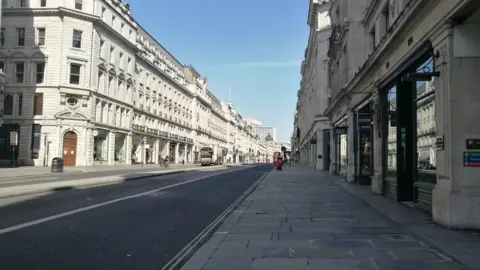Government urged to create post-Covid 'golden age' of cycling
 BBC
BBCThe government can create a "golden age of cycling" if it capitalises on the surge of interest in it during lockdown, a transport charity has said.
At one point last year, almost four times as many journeys as usual were being taken by bike, but usage has gone back to normal levels since then.
The charity Sustrans says cyclists need to feel safer and wants more 20mph zones and more effective cycle lanes.
The government said it had "ambitious plans to boost walking and cycling".
It promised to set out more details soon.
According to official statistics, road journeys taken by cyclists surged during the first lockdown last year, reaching a high point of 3.84 times the normal level on 5 May.
The figures have declined to around pre-pandemic normality.
Conversely, car journeys, which fell as low as 23% of the usual level, are now almost back to normal.

Cycling in and out of lockdown
Pete Gibbons started cycling during the first lockdown, taking his nine-year-old daughter out with him for exercise while she was being home schooled.
Encouraged by the dry, sunny weather, they started going further from their home in Brislington, on the edge of Bristol, eventually getting all the way to the city centre. "I was pleasantly surprised by the lack of traffic," he says.
"The fewer numbers of cars meant these roads felt much safer to be on," says Pete. "My daughter had never cycled on the road before and she could hear me barking directions from behind her. Her confidence bloomed."
More than a year later Pete and his daughter, now 10, are still cycling, but he says that, with more cars on the road, it "can be daunting".
"It would be really great to see more segregated and connected routes into the city centre," he adds.

Rachel White, head of public affairs at Sustrans, said: "We know that if cyclists are kept away from traffic and traffic is slower, they feel more comfortable."
Cycle lanes should be planned carefully, with more put in place "where they work", she added, while a "large-scale" government campaign should demonstrate the "health and environmental benefits" of riding a bike.
The default speed limit in built-up areas of the UK should be lowered from 30mph to 20mph, Sustrans argues. Currently it is up to local authorities to decide whether to introduce 20mph zones.
"We would like the resurgence in cycling that we saw during the lockdowns in England to herald a golden age, rather than be wasted," Ms White said.
 PA Media
PA MediaEight areas of Wales are trialling default 20mph limits in residential areas, ahead of a national rollout in 2023.
The Scottish government is also developing a "national strategy" on the issue.
And Northern Ireland's government has introduced part-time 20mph limits outside more than 100 schools.
Edmund King, president of the AA, said: "Many drivers are cyclists and most adult cyclists are also drivers."
His organisation supported "targeted 20 zones and extending well-planned cycling infrastructure", he added.
A speed limit of 30mph applies to all single and dual carriageways with street lights, unless there are signs showing it is higher or lower.

Ian Taylor, chairman of the Alliance of British Drivers, said a "flexible" approach would work better than lowering the default speed limit across England.
People were "truly used to 30mph" and would be less likely to obey the law if it was set lower, "potentially criminalising ordinary drivers", he added.
A government spokesperson said: "Last summer, the prime minister launched ambitious plans to boost walking and cycling, with a vision that half of all journeys in towns and cities are walked or cycled by 2030.
"This includes a £2bn package of funding for active travel over five years, which is the largest amount of funding ever committed to increasing cycling and walking in this country."
